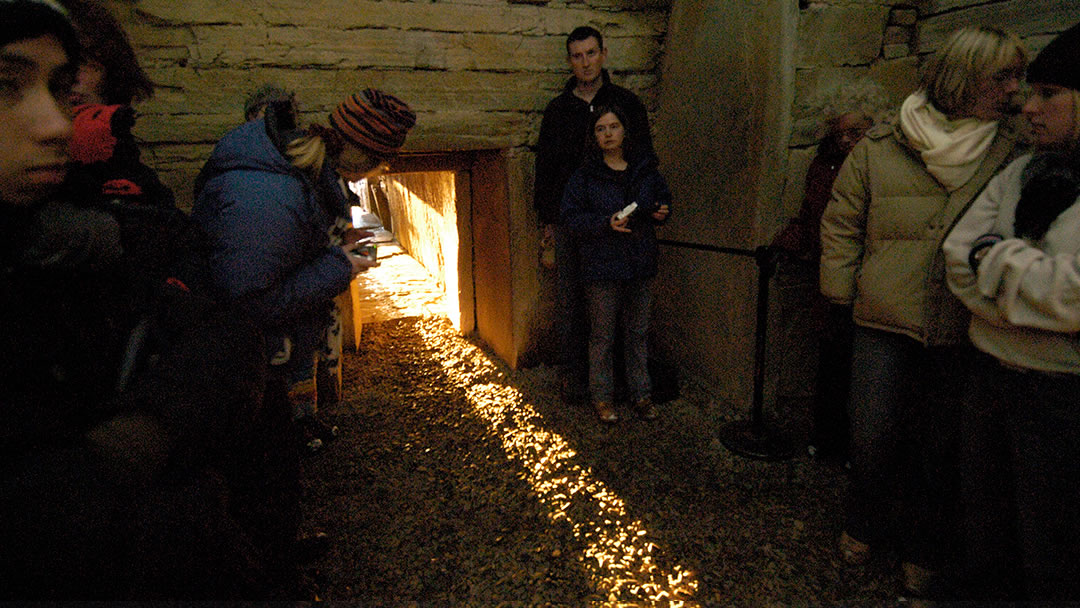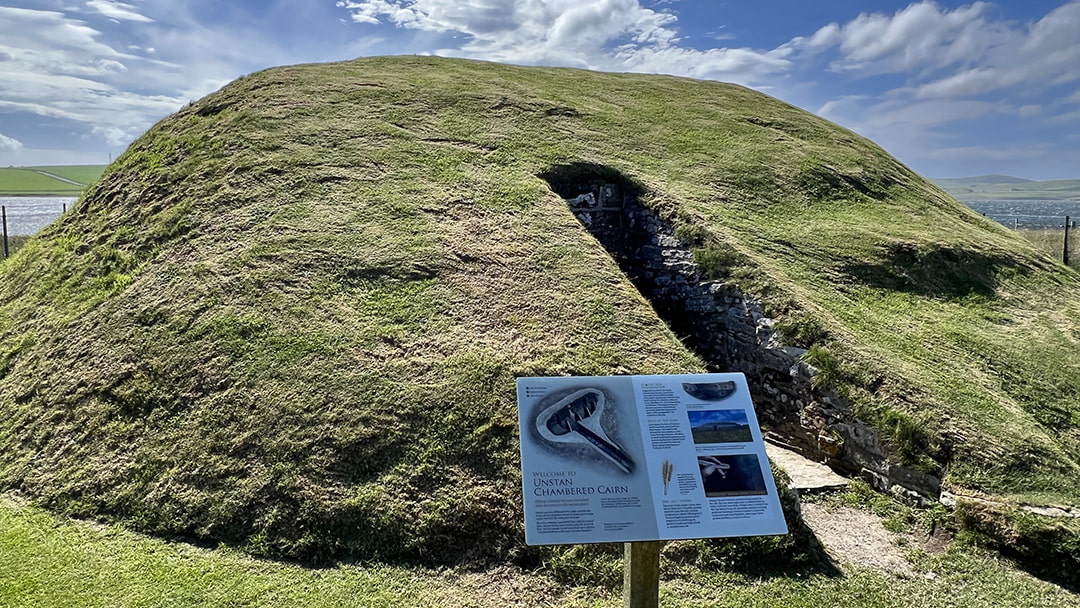Robin McKelvie in Orkney: Maeshowe and her lesser-known Orkney siblings
BBC News recently dubbed Orkney ‘Britain’s Ancient Capital’, just the latest example of how important everyone from scholarly historians to TV archaeologists consider the archipelago’s prehistory.
Maeshowe is quite simply the finest Neolithic building anywhere in northwest Europe; indeed one of the finest you’ll find anywhere in the world
Numerous world-famous Neolithic sites bring Orkney’s mainland alive, but the beauty of this island is that even when you discover one of the big hitters like Maeshowe you find tantalisingly she has lesser-known siblings, just begging to be explored.

Let’s kick off with Maeshowe, a remarkable site everyone should experience at least once in their lifetime. Orkney’s Neolithic sites are interconnected in ways we are now only really beginning to understand. Take the hulking Barnhouse Stone that strikes for the heavens by the Stones of Stenness. I learned that it is not randomly placed, but located exactly to line up with the sun and guide you into Maeshowe’s entrance, 700m away, like a homing beacon. During the Winter Solstice the sun famously beams straight down the long entrance tunnel to illuminate the rear wall of the burial chamber – if you can time your visit for this you really should, though, as with all trips to Maeshowe, book ahead as visitor number to this fragile site are understandably controlled.
My guide on this latest visit is Robert Vasey. He is clearly proud of his Neolithic chambered cairn and passageway grave of a type unique to Orkney: “Maeshowe is quite simply the finest Neolithic building anywhere in northwest Europe; indeed one of the finest you’ll find anywhere in the world.” We eke down the narrow 11m-long entrance tunnel together, delving back through centuries and then millennia as we go.

We break out into what is for me a surprisingly spacious interior. It’s quite some construction that boggles my mind – how on earth did man almost 5,000 years ago cut, drag and erect the hulking 30 tonne slabs used to build Maeshowe? It has been suggested that as many as 100,000 man hours were needed to create Maeshowe. Let that sink in for a minute.

I love that Maeshowe – in common with the other Orkney sites – seems to throw up as many questions as it does answers every time I visit. We don’t even know for certain that it was ever even used as a tomb – some scholars have suggested it was an observatory, or even others a form of calendar tying into that Winter Solstice light.
Vasey, though, has bad news – “We had a recent break in and they’ve scrawled graffiti on the walls,” he says sternly. I’m taken aback. What vandals would dare to break in here I ask? A smile returns to Vasey’s face as he reveals the intruders: “I’m afraid that they were not so much the Vandals, as the Vikings, who barged in ‘recently’. As recently in fact as 1153.” My laugh out loud in relief as much as anything echoes around the chamber.

“We don’t mind the Viking incursion, not when they left us such glorious treasure,” continues Vasey. “They left us over 30 Norse runic inscriptions, the UK’s largest hoard of runic writing. As well as the usual lewd boastings of the warriors one even talks of real treasure that was spirited off just before their raid.” Some academics say these are the largest single collection of such Runic carvings on the planet. On Orkney’s mainland I find historic treasure is laid upon layer and layer of historic treasure; every visit brings more.
And so it proves here. “If you like Maeshowe, why don’t you visit her siblings?” says Vasey. I presume he is joking, but no, he tells me about Unstan. Then Cuween. He is not done. He also suggests Wideford. My plans to hit the ‘world’s smallest gin bar’ back in Kirkwall will have to wait.

You don’t need to book a tour to Unstan, a site that lies very close to Maeshowe. Close, but I’m the only one here. It is another chambered tomb, more modest in size, but still rising up on the landscape. I plunge down the passageway into the blackness; this time without a torch-wielding guide to lead the way.
I’m armed with the basic information on the board outside, but my imagination needs little kindling as I emerge amongst the graves of my northern ancestors. They found both human and animals remains here. The wind is gone now as I survey the graves, neatly separated by stone into stalls, hence why this type of tomb is sometimes referred to as a ‘stalled cairn’.

The Unstan Chambered Cairn is contemporaneous to Maeshowe at around 5,000-years-old. A communal burial place, excavations have unearthed pottery bowls, dubbed Unstan Ware, similar to bowls found in other Orcadian Neolithic tombs. Unstan consists of a quintet of chambers and a 6m passageway. Unlike ‘similar’ tombs found on mainland Scotland the burial mound that covered the tomb is circular, and the main chamber does not open at the end of the passageway, like other ‘similar’ stalled tombs. Why? Yet more intriguing questions.

My quest is not over; it never really is in Orkney. Next I venture further afield to Cuween Hill Chambered Cairn. I feel like I’m venturing off the map now as the modern world peels away and my mobile phone signal falters. We know of Cuween’s burial function as the bones of men, dogs and oxen were found here, along with further evidence of burial rites.

Again I have come back 5,000 years, indeed today I’ve spent more time in the prehistoric world than the modern. I’m with Neolithic farmers, who came to Cuween to bury their dead. Eking down yet another dark passageway – this time on my hands and knees – I emerge to find a main chamber that leads off to four smaller side cells.
It’s hard not to think of the eight human skulls that were found here as the only sound in the dark is my breathing. I try in vain to keep my imagination in check. Thinking of the skulls of over 20 dogs that were found here doesn’t help. Reconstruction work has shown one canine skull was similar to a large collie, but with some features more in common with the European grey wolf.

Last, but certainly not least, on my own Orkney mainland cairn explorations is Wideford Hill Chambered Cairn. We’ve moved forward in time now, well to around 2,000BC. Despite the different dating it evokes for me a mini Maeshowe. Going down through the roof’s entry hatch I find an inner passageway with lintel slabs that continues to a rectangular chamber and a trio of side chambers. No bones have ever been found here, well not since the first ‘modern’ excavations in the 1840s.
I finally retreat to Kirkwall. Over a beer to toast my explorations – the gin bar sadly has closed – I hear of more cairns, some not yet named, some whose locations have not even been made public yet. The Orcadian mainland is like one beguiling Rubik’s Cube that before you even complete unfolds out into a series of even more complex smaller cubes that even if you solve you never get the whole picture. No one has the whole picture; not anyone alive today at least.
When you catch the NorthLink Ferries’ ship to the Orkney Islands do as much research as you can to appreciate the sites, but keep an open mind – you never know what you might discover.
 By Robin McKelvie
By Robin McKelvieRobin McKelvie is an award-winning travel writer and broadcaster who has been published in over 200 magazines and newspapers worldwide.
Pin it!
